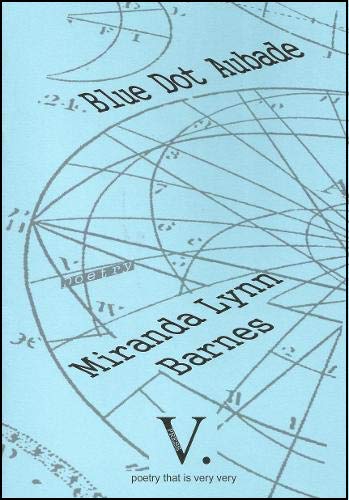 Blue Dot Aubade, Miranda Lynn Barnes
Blue Dot Aubade, Miranda Lynn Barnes
V. Press, 2020 £6.50
Colouring the universe
This pamphlet reminds us of the spectacular nature of the universe. Miranda Lynn Barnes uses that context of vastness together with astrophysical terms and gemstones to explore personal relationships, and her work brims with colour.
The opening poem ‘Olivine’ describes this gemstone’s ‘crystal / green’. The second poem, ‘The Lapidary at Green Lake’, has lovely descriptions of semi-precious stones: ‘agate, tiger’s eye, turquoise’ and
a grain of tumbled azurite, red sphere
of jasper
In ‘The Colour of Our Galaxy’, Barnes sets up a repetitive definition of the word ‘colour’ six times. She incorporates descriptions like ‘shell pink’, ‘champagne and tangerine’ and ‘descending iridescence’.
The poem ‘Blue Dot Aubade’, (‘Blue Dot’ is an image of Earth taken by Voyager 1), is a rather lovely love poem: ‘Your eyes are blue like our distant home’. This home is described as
our spinning rock that draws its colour
from areas of ocean, cloud cover, forests
The poet has a page explaining how she ‘braids’ her sequence of ‘foundation poems’ which thread through the pamphlet. Each prose poem takes a gemstone and an astronomical phenomenon as its starting point for expressing ‘human experience’. With each gemstone comes associated colour.
In ‘Topaz: Eagle Nebula – Pillars of Creation (Detail of Base)’, images of light suffuse the poem. The mother’s face is ‘cameoed against the golden-amber light’. In ‘Hyacinth/Jacinth: Cartwheel Galaxy’, ‘muscular clouds ripple in cobalt torsion as blue flashes grid the black night’. Here’s a thrilling description of light playing on dancers in ‘Amethyst: Dark Matter Distribution in Supercluster Abell 901/902’: ‘a splintering vertigo of orchid, violet, magenta haze and Byzantium wine, plum fandango, amethyst blush’.
I’m left inspired to find out more about gemstones from reading this pamphlet. Not least, I came to appreciate their extraordinarily rich variety of colours.